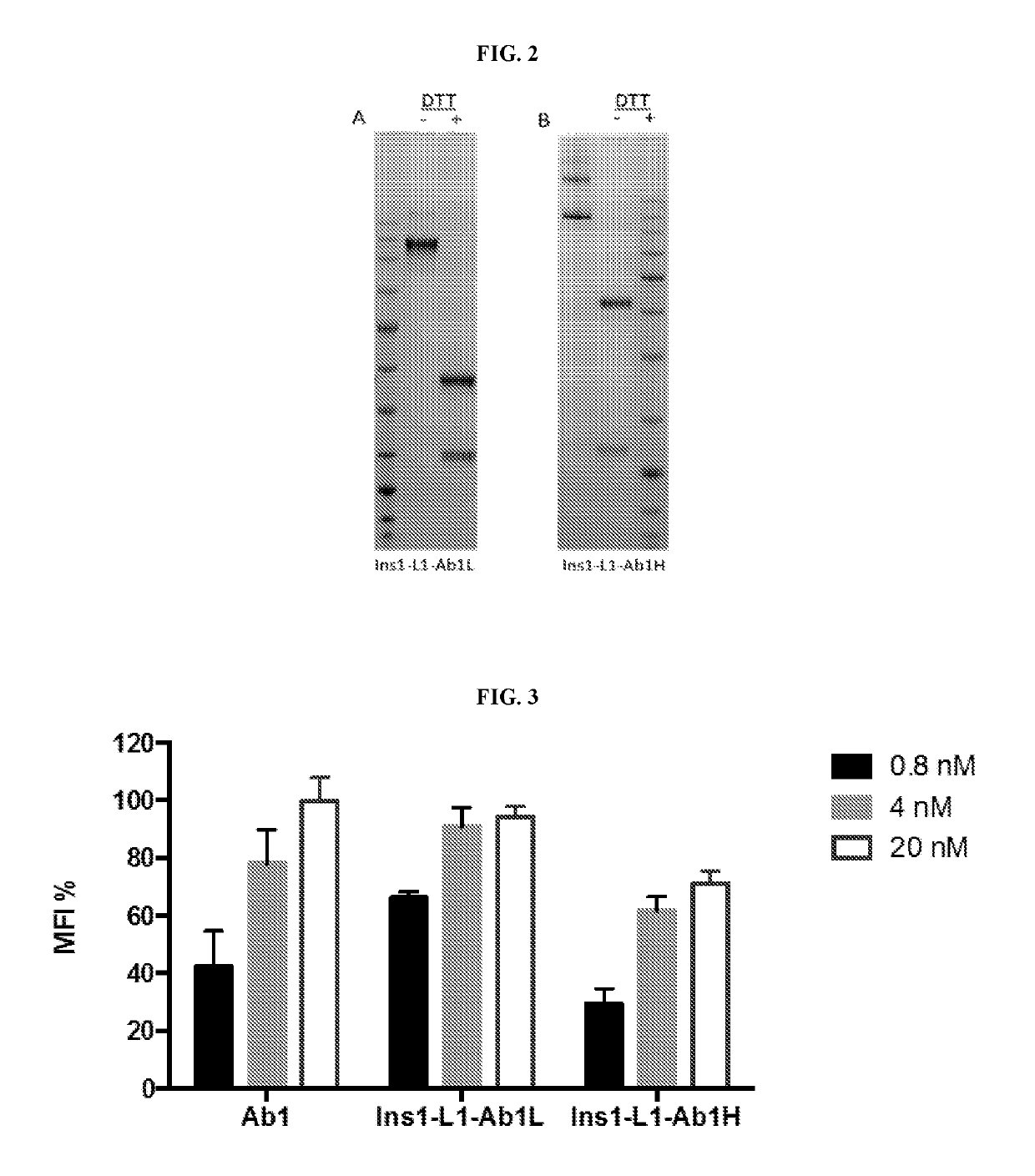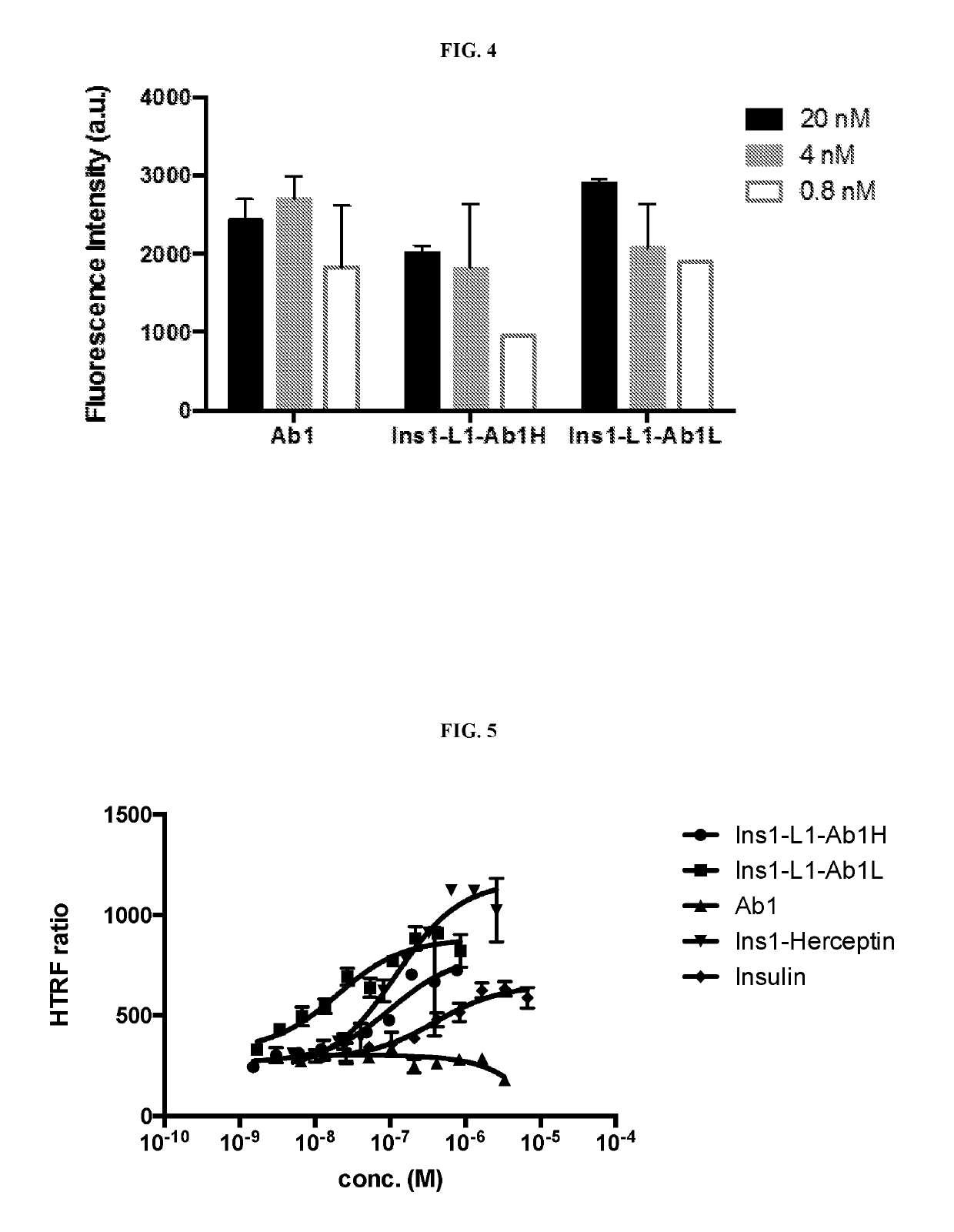Insulin immunoglobulin fusion proteins
a technology of immunoglobulin and fusion proteins, which is applied in the direction of peptide/protein ingredients, drug compositions, metabolic disorders, etc., can solve the problems of systemic insulin concentration gradient and peripheral hyperinsulinemia
- Summary
- Abstract
- Description
- Claims
- Application Information
AI Technical Summary
Problems solved by technology
Method used
Image
Examples
example 1
ion of Ins-L1-Ab1L and Ins-L1-Ab1H Fusion Proteins for Expression in Mammalian Cells
[0306]Mouse anti-human ASGPR antibody 5G3 (referred to as anti-ASGPR (5G3) or Ab1) hybridoma was obtained by immunization of mice with human ASGPR extracellular domain. Ab1 heavy chain variable region (Ab1 VH, SEQ ID NO: 11) or Ab1 light chain (Ab1 VL, SEQ ID NO: 13) variable region sequences were obtained by sequencing the Ab1 hybridoma cDNA. A mammalian expression vector encoding Ab1H (SEQ ID NO: 1) was generated by in-frame ligation of amplified Ab1 VH (SEQ ID NO: 11) and human IgG1 CH1 (SEQ ID NO: 12) to pFuse-hIgG1-Fc backbone vector (InvivoGen, CA). Genes encoding antibody Ab1 VL (SEQ ID NO: 13) and human Ig kappa CL (SEQ ID NO: 14) were amplified. The overlap-PCR product of Ab 1 VL and human Ig kappa was cloned into the pFuse vector without hIgG1 Fc fragment to generate a mammalian expression vector encoding Ab1L (SEQ ID NO: 2). The gene sequence encoding a single chain insulin with a four-poi...
example 2
n and Purification of Ins-L1-Ab1L IgG and Ins-L1-Ab1H Fusion Proteins
[0307]Ins1-L1-Ab1L (SEQ ID NO: 79) and Ab1H (SEQ ID NO: 29), collectively, Ins1-L1-Ab1L IgG, was expressed through transient transfection of FreeStyle HEK 293 cells with expression vectors of Ab1H (SEQ ID NO: 1) and Ins1-L1-Ab1L (SEQ ID NO: 58), according to the manufacturer's protocol. Briefly, 28 mL FreeStyle HEK 293 cells containing 3×107 cells were seeded in a 125 mL shaking flask. 15 μg of plasmid encoding Ins1-L1-Ab1L and 15 μg of plasmid encoding Ab1H diluted in 1 mL Opti-MEM medium were added in 1 mL Opti-MEM containing 60 μL 293fectin (Invitrogen, Inc). After the plasmids were incubated with 293fectin for 30 min, lipoplex mixture was added to the cell suspension. Cells were then shaken at 125 rpm in a 5% CO2 environment at 37° C. Culture medium containing secreted proteins (Ins1-L1-Ab1L IgG) were harvested every 48 hours, twice after transfection. Ins1-L1-Ab1L IgG was purified by Protein G chromatography (...
example 3
b1L IgG and Ins-L1-Ab1H IgG Fusion Proteins Binding Assay for Human ASGPR
[0308]The activity of anti-ASGPR within the Ins1-L1-Ab1L IgG (SEQ ID NOS: 79, 29) and Ins1-L1-Ab1H IgG (SEQ ID NOS: 78, 30) fusion proteins for human ASGPR was tested by ELISA assay. Briefly, 100 ng / well ASGPR antigen (human, rat and cyno monkey) was coated on 96-well plate in PBS at 4° C. overnight; the wells were blocked with 2% milk / PBST (0.5% Tween-20 in PBS) at room temperature for 1 hr; antibodies were added in concentrations of 10 nM, 1 nM and 0.1 nM in 2% milk / PBST at room temperature for 2 hr; the wells were washed with PBST 4-5 times; anti-light chain kappa (sigma A7164) in 2% milk / PBST was added and the plate incubated at room temperature for 1 hr; the wells were washed with PBST 4-5 times; and the reaction was developed with QuantaBlu fluorogenic peroxidase substrate (Life technologies, 15169), and quantified using a Spectramax fluorescence plate reader with excitation at 325 nm and emission at 420 ...
PUM
| Property | Measurement | Unit |
|---|---|---|
| induction time | aaaaa | aaaaa |
| particle size | aaaaa | aaaaa |
| pH | aaaaa | aaaaa |
Abstract
Description
Claims
Application Information
 Login to View More
Login to View More - R&D
- Intellectual Property
- Life Sciences
- Materials
- Tech Scout
- Unparalleled Data Quality
- Higher Quality Content
- 60% Fewer Hallucinations
Browse by: Latest US Patents, China's latest patents, Technical Efficacy Thesaurus, Application Domain, Technology Topic, Popular Technical Reports.
© 2025 PatSnap. All rights reserved.Legal|Privacy policy|Modern Slavery Act Transparency Statement|Sitemap|About US| Contact US: help@patsnap.com



